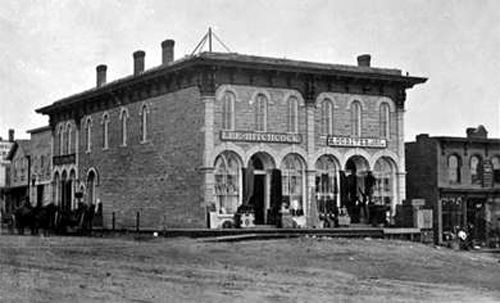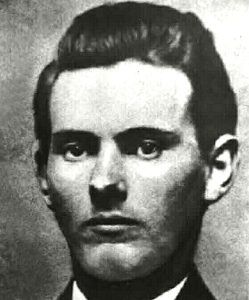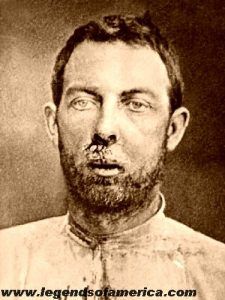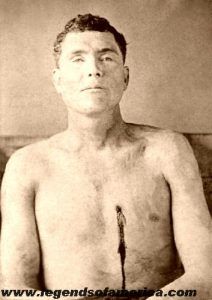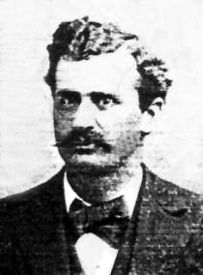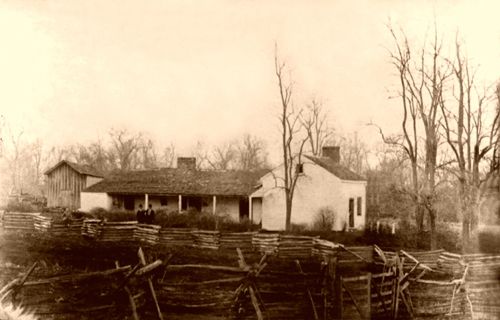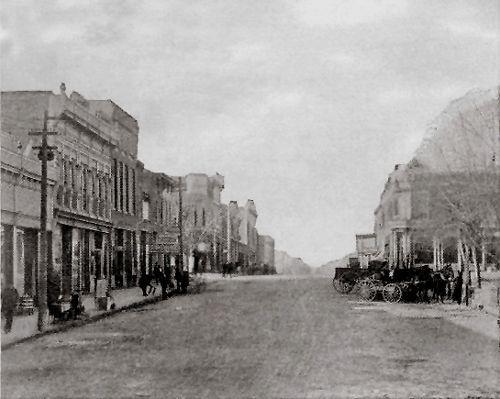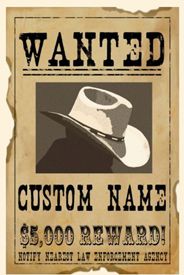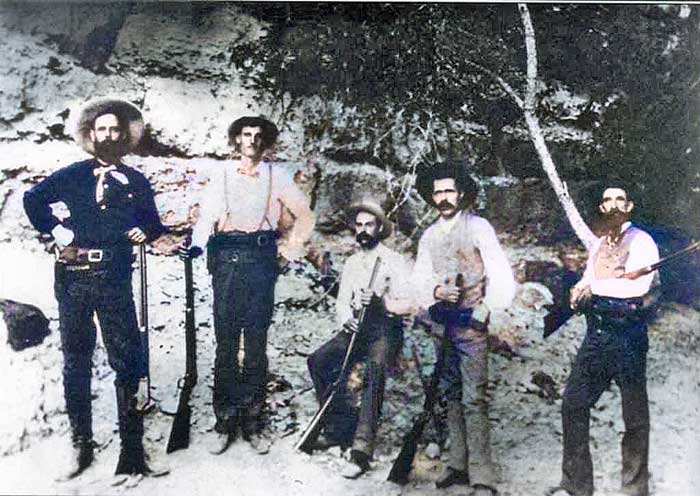
James Younger Gang, circa 1869.
During the Civil War, both the James and Younger brothers followed William Quantrill’s lead in a band of ruthless bushwhackers, gaining a taste for violence in the bitter conflict that ravaged the divided state of Missouri.
Robbing banks, trains, and stagecoaches for ten years, the gang’s postwar crimes began in 1866. However, it wasn’t until 1868 that authorities determined that Cole Younger, Jesse James, and Frank James were involved in the crime spree, which led to the gang being called the James-Younger Gang. The gang soon became one of the most famous in American history and included numerous outlaw members who shifted from one crime to the next.
Many of the gang members met during the Civil War, most of whom rode with Quantrill’s Raiders. Missouri was a divided state, with most residents supporting the southern cause, but the state declared for the Union. The gang of bushwhackers was involved in several conflicts, most in Missouri and surrounding states. Before, during, and after the Civil War, both the James and Younger brothers were outspoken partisans for the South. When the war was over, these men who had fought mainly in guerrilla bands were embittered and continued to associate with their old war comrades. During the tumultuous Reconstruction era in Missouri, many former soldiers turned to a life of crime.
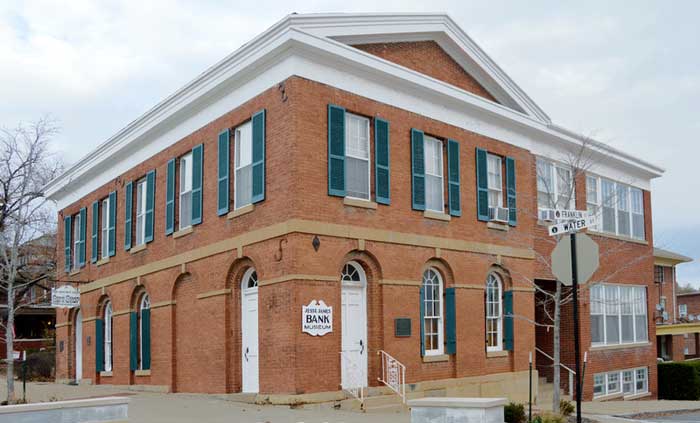
The first bank to be robbed by the James-Younger Gang was in Liberty, Missouri, on February 13, 1866. Photo by Kathy Alexander.
Their first robbery took place on February 13, 1866, when the gang stormed the Clay County Savings Association in Liberty, Missouri, stealing over $60,000 in cash and bonds. It was the first daylight, peacetime, armed bank robbery in U.S. history, and when the outlaws were making their escape, gunfire erupted, and an innocent 17-year-old boy by the name of George Wymore was killed.
Missouri authorities suspected that a known Confederate guerrilla leader named Archie Clement was the group leader, and soon, a price was put on his head. Fearless, however, Clement next led the gang in robbing the Alexander Mitchell and Company Bank in Lexington, Missouri, on October 30, 1866, making off with about $2,000. Afterward, Clement began to lead the gang in intimidating Missouri residents to sway their votes against the Republican Party in an upcoming election. When the Missouri State Militia got involved, he was killed on December 13, 1866.
Despite the loss of their leader, the outlaws remained together and continued their crime spree for the next decade, allegedly involved in the following robberies:
| Date | Robbery | City | Amount |
| February 13, 1866 | Clay County Savings Association | Liberty, Missouri | $62,000.00 |
| October 30, 1866 | Alexander Mitchell and Co. Bank | Lexington, Missouri | $2,000.00 |
| March 2, 1867* | Judge John McClain Banking House* | Savannah, Missouri | Unknown* |
| May 22, 1867 | Hughes and Wasson Bank | Richmond, Missouri | $4,000.00 |
| March 20, 1868 | Nimrod Long Banking Co. | Russellville, Kentucky | $14,000.00 |
| December 7, 1869 | Davies County Savings Bank | Gallatin, Missouri | $700.00 |
| June 3, 1871 | Ocobock Brothers’ Bank | Corydon, Iowa | $6,000.00 |
| April 29, 1872 | Bank of Columbia | Columbia, Kentucky | $600.00 |
| September 26, 1872 | Kansas City Exposition Ticket Office | Kansas City, Missouri | $10,000.00 |
| May 27, 1873 | St. Genevieve Savings Bank | St. Genevieve, Missouri | $4,100.00 |
| July 21, 1873 | Chicago, Rock Island & Pacific Railroad | Adair, Iowa | $6,000.00 |
| January 15, 1874 | Stagecoach | Hot Springs, Arkansas | $3,000.00 |
| January 31, 1874 | Iron Mountain Railroad | Gad’s Hill, Missouri | $12,000.00 |
| April 7, 1874 | Stagecoach | Austin-San Antonio, Texas | $3,000.00 |
| August 30, 1874* | Two Stagecoaches* | Waverly-Lexington, Missouri | Unknown * |
| December 7, 1874 * | Tishomingo Savings Bank* | Corinth, Mississippi | $10,000.00 * |
| December 8, 1874 | Kansas Pacific Railroad | Muncie, Kansas | $55,000.00 |
| September 5, 1875 | Huntington Bank | Huntington, West Virginia | $10,000.00 |
| July 7, 1876 | Missouri Pacific Railroad | Otterville, Missouri | $15,000.00 |
| September 7, 1876 | First National Bank | Northfield, Minnesota | $0 |
* Some historians question whether the James-Younger Gang really made this robbery
The attempted robbery in Northfield, Minnesota, would spell the death of the James-Younger Gang, though a later gang would be formed called the James Gang. After taking the train to Minneapolis in early September 1876, the group split up. One party went to Mankato and the other to Red Wing on either side of Northfield, Minnesota. After scouting the area, they attempted to rob the Northfield bank on September 7, 1876. Jesse and Frank James, along with Bob Younger, went inside the bank while Cole and Jim Younger, Bill Chadwell, Clell Miller, and Charlie Pitts stood guard outside.
Inside the bank, the three outlaws demanded that the vault be opened and that the money be surrendered. However, Joseph Lee Heywood, the bank clerk on duty, refused to do so and was shot and killed. Hearing shots, Northfield citizens realized that a robbery was in progress and, taking up arms, began to shoot at those outside, killing Miller and Chadwell and hitting Cole Younger in the thigh. In the meantime, Jesse, Frank, and Bob Younger fled from the bank, and Bob was shot in the right elbow. Returning the fire, the gang killed Nicholas Gustavson, a Swedish man who was caught in the crossfire.
The surviving gang members then took off and were quickly pursued by posses. Near Mankato, the gang split up, with the Younger brothers and Charlie Pitts going one way and the James brothers going another. After covering some 400 miles in the search for the outlaws, the posse caught up with the Youngers near Madelia, Minnesota, on September 21, 1876. After a gunfight erupted, Charlie Pitts was killed, and the Younger brothers were further wounded. Finally, they surrendered.
Tried in Faribault, Minnesota, they were found guilty of murder and sentenced to 25 years in the state prison at Stillwater. Bob Younger died in prison in 1889; Jim was pardoned in 1901 but committed suicide the following year; and Cole, who was also pardoned in 1901, lived until 1916.
In the meantime, the James brothers had escaped and made their way back to Missouri. They then moved to Nashville, Tennessee, where they lived peacefully for the next three years. However, the restless Jesse began a new gang in 1879 and renewed his criminal career, leading the James Gang. Until he died in 1882, the outlaws again robbed banks, trains, and stagecoaches.
Throughout the successful years of the James-Younger Gang, the prominent members were:
Alexander Franklin James (1843-1915) – Frank surrendered in October 1882 and was tried twice but was acquitted both times. He died of a heart attack on February 18, 1915.
Jesse Woodson James (1847-1882) – James Gang member Robert Ford murdered Jesse on April 3, 1882.
McClelland “Clell” Miller (1850-1876) – He was killed during the Northfield, Minnesota bank robbery on September 7, 1876.
James “Jim” Younger (1848-1902) – After serving 25 years in prison for the Northfield, Minnesota, attempted robbery, he was released in 1901 and killed himself on October 19, 1902.
John Harrison Younger(1851-1874) – Killed in a shoot-out with Pinkerton Agents near Roscoe, Missouri, on March 17, 1874.
Thomas Coleman “Cole” Younger (1844-1916) – After serving 25 years in prison for the Northfield, Minnesota, attempted robbery, he was released and died on March 21, 1916.
Robert “Bob” Ewing Younger (1853-1889) – After the failed robbery attempt in Northfield, Minnesota, he was sent to prison and died there of tuberculosis on September 16, 1889.
Other Members:
James “Jim” Anderson – Brother to William “Bloody Bill” Anderson, Jim was thought to have been killed by fellow James-Younger Gang member George Shepherd in Austin, Texas.
Bill Chadwell, aka William Stiles, Jack Ladd, J. Ward (1840s-1876) – Killed in the attempted bank robbery at Northfield, Minnesota, on September 7, 1876.
Archibald J. “Little Archie” Clement (1846-1866) – A federal guerrilla under William “Bloody Bill” Anderson in the Civil War, he later was the first leader of the James-Younger Gang. Missouri State Militia killed him on December 13, 1866.
Jacob Franklin Gregg (1844-1906) – He was part of the gang during their first robbery of the Clay County Savings Association in Liberty, Missouri. Later, he moved to Texas, where he died in 1906.
John Jarrette (1836-1868? or 1906?) – After participating in five bank robberies, he is thought to have died in a house fire in 1868. More recently, however, strong proof surfaced that he died in Greenwood, British Columbia, Canada, where the Greenwood Heritage Society recently unveiled a new grave marker for the elusive outlaw.
Hobbs Kerry – Participated only in the Otterville, Missouri train robbery and spent two years in prison.
Arthur C. McCoy (1825-1880?) – After participating in several robberies and killing a Pinkerton agent, he moved his family to Texas, where he was thought to have died in 1880.
Redmond “Red” Munkirs (or Munkers) (1845-1867) – He was with the gang in their first robbery of the Clay County Savings Association in Liberty, Missouri. Shot and killed by the Missouri State Militia on May 18, 1867.
Allen H. Parmer (1848-1927) – Rode with William Quantrill during the Civil War and afterward was allegedly present during the Clay County Savings Association robbery in Liberty, Missouri, on February 13, 1866. Later married Susan Lavinia James, sister of Frank and Jesse James, and moved to Texas, where he died on October 25, 1927.
Alexander Doniphan “Donnie” Pence (1847-1896) – He rode with William Quantrill during the Civil War and allegedly participated in the Liberty, Missouri Bank Robbery in 1866. He later became a respected sheriff in Nelson County, Kentucky, and died of typhoid fever in 1896.
Thomas Edward “Bud” Pence (1842-1880) – Rode with William Quantrill during the Civil War and allegedly participated in the Liberty, Missouri Bank Robbery in 1866. He died in 1880.
Charles “Charlie” Pitts – He was killed after the failed robbery of the Northfield, Minnesota bank on September 7, 1876.
George Washington Shepherd (1842-1917) – He served three years in prison for the Bank of Columbia robbery in Kentucky in 1872.
Oliver Shepherd (1842-1868) – He was killed by a posse in Jackson County, Missouri, on April 4, 1868.
Charles Fletcher Taylor (1842?-1912) – Rode with William Quantrill during the Civil War and allegedly participated in the Liberty, Missouri Bank Robbery in 1866. He was later elected to the State Legislature and died in 1912.
Victims of the James-Younger Gang:
Dan Askew (18??-1875) – A neighbor east of the James Farm near Kearney, Missouri, Askew was found dead on April 12, 1875. Askew was believed to have harbored Pinkerton Spy Jack Ladd, and the killing was thought to have been in revenge for the Pinkerton bombing of the James Farm in January 1875. Afterward, everyone in Clay County who did not consider the James boys heroes grew too frightened to speak out against them.
Alonzo E. Bunker (18??-1876) – The Assistant Cashier at the First National Bank in Northfield, Minnesota, was shot in the shoulder during the attempted robbery on September 7, 1876. However, Bunker would recover.
Edwin B. Daniels (18??-1874) – St. Clair County, Missouri Deputy Sheriff killed by Jim Younger near Roscoe, Missouri on March 17, 1874.
Dennis Foley – On July 21, 1873, the James-Younger Gang made their first train robbery at Adair, Iowa. The gang hid along a bank after disconnecting two rails of the track and pulling out the spikes. Anticipating that the engineer would stop, the plan failed when Engineer John Rafferty instead slammed on the air brakes, and the train derailed, killing Rafferty when the engine crushed him. Fireman Dennis Foley was also seriously injured. Though things didn’t go as the gang planned, they went on to rob the train and its passengers of some $6,000.
B.G. Griffin (18??-1867) – On the afternoon of May 22, 1867, the James-Younger Gang appeared in Richmond, Missouri, to rob the Hughes and Wasson Bank. During the robbery, three men were killed, including B.G. Griffin, when he came to the aid of his dying son, Frank S. Griffin.
Frank S. Griffin (18??-1867) – On the afternoon of May 22, 1867, the James-Younger Gang appeared in Richmond, Missouri, to rob the Hughes and Wasson Bank. During the robbery, three men were killed, including Frank Griffin, who was shot in the head. Upon seeing this, his father, B.G. Griffin, raced to the aid of his dying son and also received a shot in the head.
Nicholas Gustavson (18??-1876) – A Swedish immigrant who is thought not to have been able to understand the warnings coming from Northfield, Minnesota, citizens, was shot down in the hail of gunfire during the attempted robbery of the First National Bank on September 7, 1876.
Joseph Lee Heywood (1837-1876) – Acting Cashier at the First National Bank in Northfield, Minnesota, Heywood refused to open the safe for the members of the James-Younger Gang on September 7, 1876. Though the men threatened to slit his throat, he continued to refuse and was shot by Frank James.
Jack Ladd, a Pinkerton Agent, posed as a farmworker for Dan Askew, a neighbor of the James Farm. Ladd and Askew were both killed on April 12, 1875, in revenge for the Pinkerton bombing of the James Farm in January 1875.
Captain Louis J. Lull, aka: W.J. Allen (18??-1874) – A Pinkerton Agent from Chicago, Illinois, Lull was killed by John Younger near Roscoe, Missouri on March 17, 1874.
Nimrod Long – When the James-Younger Gang robbed his bank in Russellville, Kentucky, on March 20, 1868, a bullet was fired at his head. Fortunately for the banker, the shot grazed him, and though he fell to the floor, he easily survived the scalp wound.
R.A.C. Martin (18??-1872) – Martin was the Cashier at the Bank of Columbia, Kentucky, when the James-Younger Gang robbed it on April 29, 1872. Unfortunately, Martin made the mistake of going for a pistol, and for his attempt at bravery, he was shot and killed.
Judge James Garnet – President of the Bank of Columbia, Kentucky, when the James-Younger Gang robbed it on April 29, 1872. Garnet was shot in the hand during the robbery, which caused it to be amputated years later.
Judge John McClain – Shot in the arm on March 2, 1867, during the attempted robbery of his bank in Savannah, Missouri. McClain recovered.
John Rafferty (18??-1873) – On July 21, 1873, the James-Younger Gang made their first train robbery at Adair, Iowa. The gang hid along a bank after disconnecting two rails of the track and pulling out the spikes. Anticipating that the engineer would stop, the plan failed when Engineer John Rafferty instead slammed on the air brakes, and the train derailed, killing Rafferty when the engine crushed him. Though things didn’t go as the gang planned, they went on to rob the train and its passengers of some $6,000.
John B. Shaw (18??-1867) – On the afternoon of May 22, 1867, the James-Younger Gang appeared in Richmond, Missouri, to rob the Hughes and Wasson Bank. During the robbery, three men were killed, including Mayor John B. Shaw, who was shot in the chest.
John W. Sheets (18??-1869) – When the James-Younger Gang robbed the Davies County Savings Bank in Gallatin, Missouri, on December 7, 1869, they shot Sheets in the head. Allegedly, the gang thought that it was Major S. P. Cox who killed William “Bloody Bill” Anderson.
Unknown Girl – When the gang robbed the Kansas City Exposition on September 26, 1872, there was a dispute with the ticket seller, and a stray bullet hit a young girl in the leg. She recovered.
John W. Whicher (18??-1874) – A Pinkerton Detective who had been sent to investigate the James Brothers in Jackson County, Missouri. Unfortunately, upon his arrival, he let one too many people know about his plans and was soon found shot to death alongside a rural road on March 11, 1874.
George Wymore (1849?-1866) – After making their first robbery on February 13, 1866, in Liberty, Missouri, shots were fired upon making their escape. Unfortunately, a stray bullet hit innocent 17-year-old Wymore, who was standing in front of the Green Hotel. Later, the family would say that they received a letter of apology from Jesse James.
© Kathy Alexander/Legends of America, updated September 2025.
Also See:
Jesse James – Folklore Hero or Cold-Blooded Killer?
Modern Bad Men – A 1907 Account
See Sources.

